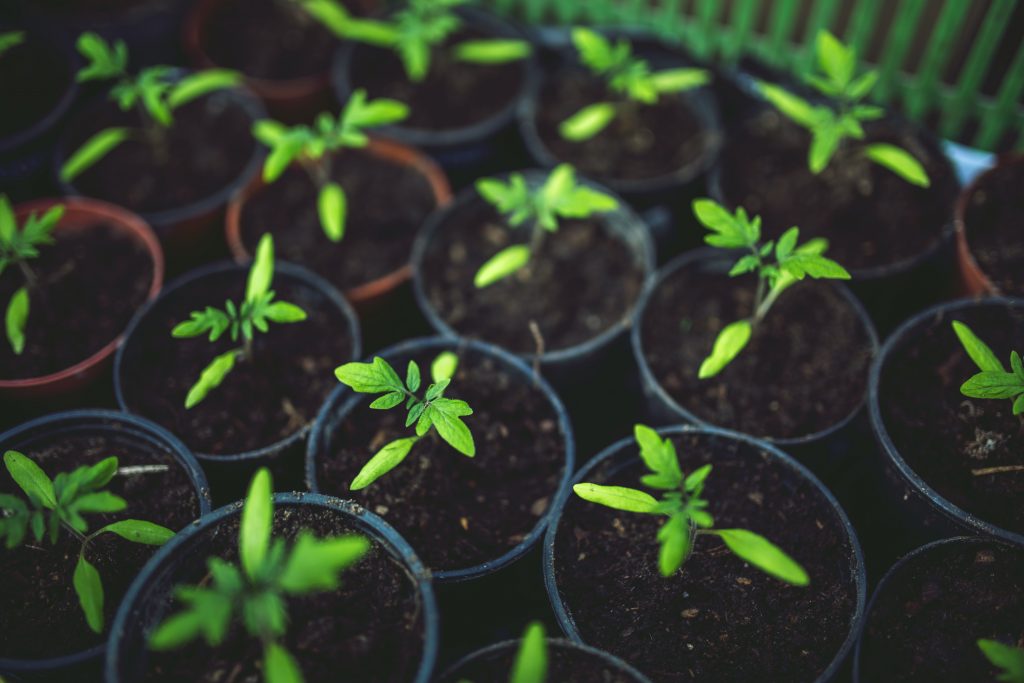Starting Seeds Indoors

With the spring weather we’ve recently had many of us are thinking of our gardens. You might think it is too early to plant seeds, but it is not. You can plant seeds indoors.
Why plant seeds indoors?
- Some vegetable and flowers need a longer growing season than we have in Wisconsin. They simply don’t have time to mature if started outside. Plants like tomatoes, eggplant, and peppers fall into this category.
- Some seeds are so tiny they are easily blown away by the wind or washed away in the rain. You’ll get more plants from a seed packet if you eliminate these dangers. Lettuce and basil are good examples.
- You may also want to stagger your planting, starting some seeds now, and others outside later. Doing this gives you two rounds of produce! For instance, if you are a fan of green beans, you could plant some bush beans inside a couple of weeks before the last frost, then direct sow more seeds outside when you transplant the seedlings you grew. You will have fresh-picked green beans to eat for a long time!
- It can be just plain fun to see something grow this time of year!
Be aware, though, that not all plants like to be moved, and some are best started outdoors at the appropriate time. Root vegetables like carrots, turnips, radishes, and potatoes don’t like to be disturbed once planted. Vining vegetables like cucumber, squash, pumpkins, and zucchini can also be tricky to transplant.
How To Start Seeds Indoors
First, read the directions on each seed package. The package will tell you when and where to plant, and how many weeks before or after the date of last frost. In our area, the magic date is about May 10, (some sources say as early as May 4 or as late as May 18) so you will want to count the weeks before of after that. The package will also tell you how deep to plant the seeds, and whether you should plant one or more of them in each hole, or simply scatter them over the soil.
Your seeds will need a warm place to grow, light, water, seed starting mix, containers, and plastic wrap or clear cover. It is helpful to have a warming mat and a grow light. You can buy seed starting kits online or in stores. These usually contain a tray with dividers and a plastic lid, and possibly a light or warming mat. Some of these are self-watering, allowing you to add water to the bottom of the tray, and some even have little pellets of seed starting mix. You can also use any old container you have, such as yogurt or deli containers, egg cartons, etc. Just remember to poke a hole in the bottom for drainage!
Seed starting mix is primarily made of peat moss or coco coir, and perlite or vermiculite. Some have a little compost mixed in. Some have fertilizers. Why not just use potting soil or regular old topsoil? Two reasons: 1. Seed starting mix is lighter than soil. It holds just the right amount of moisture, letting excess drain through. It is also easier for little sprouts to push through. 2. It is sterile, which means your seedlings won’t be fighting diseases and fungi from the start. If you have concerns about sustainability, there are lots of organic options. Also be aware that using coco coir is much more environmentally friendly than peat.
Fill your containers with mix, plant the seeds according to the package directions, water very gently, then mark the containers so you know what you planted. Put the lid on or cover them loosely with plastic wrap to make a little greenhouse for your seeds. Place the whole tray on the warming mat under bright light. A south facing window works for some seeds, but some seedlings are happier with a toasty mat under them and a good light above. You can buy a grow light to place directly above the tray. A plain old fluorescent light works fine, too. Give them about 16 hours of light each day. Check the mix frequently, keeping it moist but not wet. Once your seedlings are almost touching the lid or plastic wrap, it is time to remove it. Keep the seedlings warm, watered and under a light source until they are ready to plant. Before planting them outdoors, make sure to get them used to the environment by placing them outside for increasingly longer periods of time over several days. This is called hardening off.
Starting seeds indoors can be really rewarding and a lot of fun. It is a great activity to do with kids too. But if this just sounds like a lot of work, no need to worry. You don’t need to start seeds indoors to have a great garden. You can buy vegetable and flower seedlings at Pleasant Prairie Greenhouse.
Our store at N5391 Hwy 104 between Albany and Brodhead will be open for SEED SALES ONLY (no plants available) 9-4 Mon-Fri starting on April 4.
All locations are fully open starting April 16!
